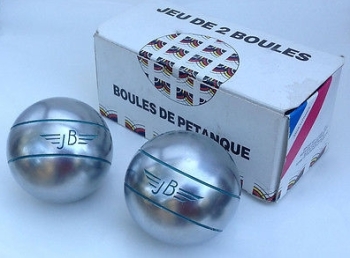[updated 2022-01-11] See also our post on buying boules.
Probably the second most-frequently-asked question about boules (after What is the difference between leisure boules and competition boules?) is—
Can I use this set of boules in an FIPJP-sanctioned competition?
How can I tell whether this is a leisure boule or a competition boule?
When you have such a question, look at two things.
 Look at the packaging
Look at the packaging
If you just bought a new set of boules, or are thinking about buying a new set of boules, look at the packaging. The packaging of a set of competition boules will display the FIPJP’s V-shaped, rainbow-colored logo and the words boules homologuées (“certified boules”) or some variation on those words— boules de compétition homologuées— homologué en compétition par la FIPJP— agréés par la FIPJP en compétition.

If you don’t see those words or the FIPJP logo, the boules are not competition boules.
 Note that manufacturers often sell both competition boules and leisure boules, so the name of a reputable French manufacturer does not mean that the boules are competition boules. If the packaging does not display the FIPJP logo and the “certified” label, the boules are not competition boules. These classic JB boules look great… but they are not competition boules.
Note that manufacturers often sell both competition boules and leisure boules, so the name of a reputable French manufacturer does not mean that the boules are competition boules. If the packaging does not display the FIPJP logo and the “certified” label, the boules are not competition boules. These classic JB boules look great… but they are not competition boules.
If you’ve bought a set of used boules on eBay, be alert. Look at the boules themselves and don’t trust the packaging. I’ve seen leisure boules offered on eBay in a cardboard box that originally contained competition boules.
Look at the boules
How can you tell— by looking at a boule— whether or not it is a competition boule?
First, look for indicators that it is a leisure boule.
- If the boule is marked with the phrase “Made in France”, it is a leisure boule.
- A very bright, shiny chrome finish, along with rounded (rather than crisply-cut) edges on grooves, is the hallmark of an inexpensive Chinese-made leisure boule.
- Other hallmarks of inexpensive Chinese-made leisure boules include— packaged in a soft-sided bag (containing 3, 6, or 8 boules) that includes a small jack and a measuring string with two plastic ends. Typically the bag is marked with a single word— “petanque” or “boules” or “bocce”.

If that doesn’t answer the question, look for indicators that it is a competition boule. Competition boules are required to display three pieces of information.{1}
- the manufacturer’s name (or logo) and the name (or logo) of the model of boule.
- the weight (poids) of the boule in grams. This is a number between 650 and 800.
- a set identifier. This is a combination of letters and/or numbers that uniquely identifies a particular set of boules. All of the boules in the set will have the same ID.{2}
A boule that is missing any any of these required marking is not a competition boule and may not be used in an FIPJP-sanctioned competition.{3}{4}
Note that a competition boule may contain other markings as well. La Franc stamps their boules with the size (diamèter) of the boule. MS Petanque boasts that the complete markings on its boules give you all of the information about the boule, including the year it was manufactured (l’année de fabrication). And of course a previously-used set of boules may be stamped with the name or initials of its original owner.

The bottom line
The bottom line is that the ultimate test for whether or not a boule can be used in an FIPJP-sanctioned competition is the presence or absence of all three of the pieces of information that are required to be stamped onto all FIPJP-certified boules.
FOOTNOTES
{1} Note that these requirements are not stated in the rules for the game of petanque. They are in the FIPJP’s rules for the certification of boules.
{2} Some boule manufacturers occasionally sell— at steeply discounted prices— sets of competition boules that have mis-matched IDs. Note that such boules are allowed in competitions. FIPJP rules require that all of a player’s individual boules must be certified, but not that they must all come from the same set.
{3} Note that not every boule without these marking is a leisure boule. Very rarely, a boule without the required markings is a good-quality French boule manufactured before 1974, when the FFPJP first began requiring markings on competition boules. Still, without the required markings, such older boules may not be used in FIPJP-sanctioned competitions.
{4} Note that “open” competitions (such as the Amelia Island Petanque Open, in Florida) often have no requirements about the kind of boules the participants use.
